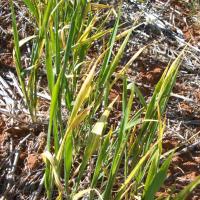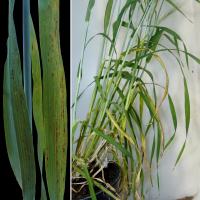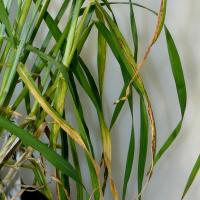Diagnosing wheat streak mosaic virus
Wheat streak mosaic virus (WSMV) is a seed and mite-borne virus that infects cereals (including wheat and barley) and grasses. WSMV is spread by the wheat curl mite (WCM) and requires a green-bridge to survive between growing seasons. Substantial yield losses are likely if infection occurs early.
What to look for
- Yellow stunted plants in patches, scattered on the edge or within the paddock.
- Symptoms are less obvious in winter. The virus spreads with warm weather in autumn and spring when mites build up and they move between plants.
Paddock
- Symptoms are seen in warm growing conditions, generally before June or from early spring.
- Wheat is the most important host of WSMV and all varieties are susceptible.
- Leaves of newly infected wheat plants have broken yellow stripes that join together as the plant ages to be pale yellow streaks. In older leaves, yellowing is toward tips.
- Barley is less severely affected than wheat and varieties differ in their susceptibility to infection.
- Barley leaves have necrotic flecks and pale green streaks with older leaves showing yellow along the length.
- Early infected wheat and barley plants are stunted with multiple tillers and have seed heads that contain shrivelled or no grain.
Plant
What else could it be
| Condition | Similarities | Differences |
|---|---|---|
| Diagnosing yellow dwarf virus | Yellow interveinal chlorosis leaf streaks | WSMV has less vivid stripes. WSMV affect younger leaves causing broken stripes that join as the leaf ages. |
| Diagnosing zinc deficiency in wheat | Stunted plants with many tillers and striped leaf lesions | Zinc deficient plants have pale linear spots or lesions that can develop into parallel 'tramlines' and they lack vivid yellow streaks towards the leaf tip. |
Where did it come from?

Insect vector

Green bridge

Contaminated seed
- The wheat curl mite that spreads WSMV is tiny and can only be seen with a microscope. They survive on self-sown cereals and grasses, and thrive in warm conditions (25-28°C).
- During seasons of late summer and early autumn rainfall large populations of the mites can develop on 'green bridge' hosts and then move to infest autumn sown crops.
- Sowing infected seed produces virus infected seedlings from which mites can pick up the virus and spread it to other plants.
- Seed infected with even very low levels of the virus can cause significant yield losses as infection is able to take hold early in the season.
Management strategies
- There is no treatment after plants are infected. To minimise infection:
- Control 'green bridge' volunteer cereal plants and grass weeds as they harbour both WSMV and WCM. This needs to be done 1 month prior to sowing.
- Sow clean seed.
- Avoid early seeding in virus risk conditions, such as seeding directly into a recently sprayed out 'green bridge' or using infected seed, as warm seasonal conditions during autumn favour high wheat curl mite populations.
See also
Where to go for expert help
Page last updated: Wednesday, 20 May 2015 - 3:43pm







